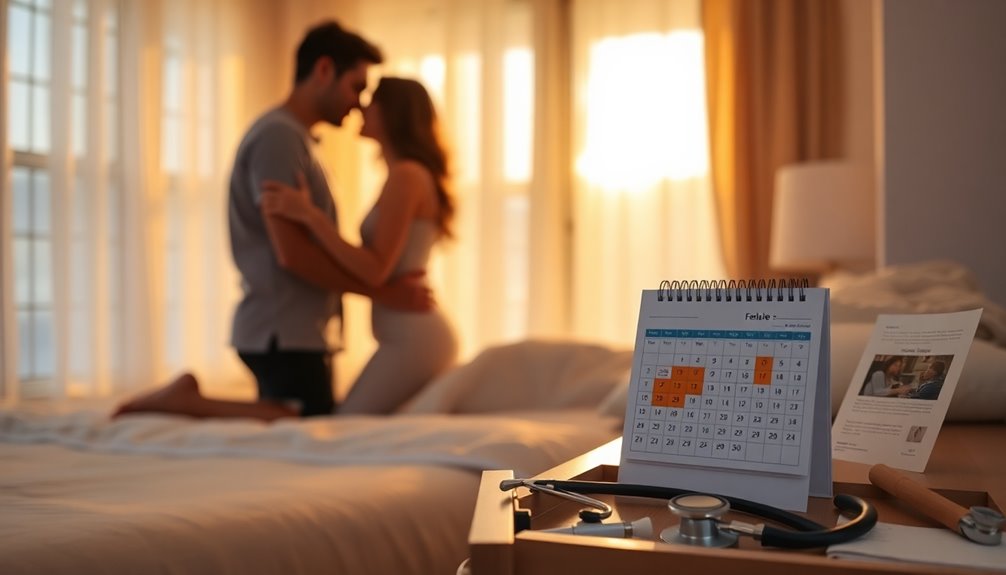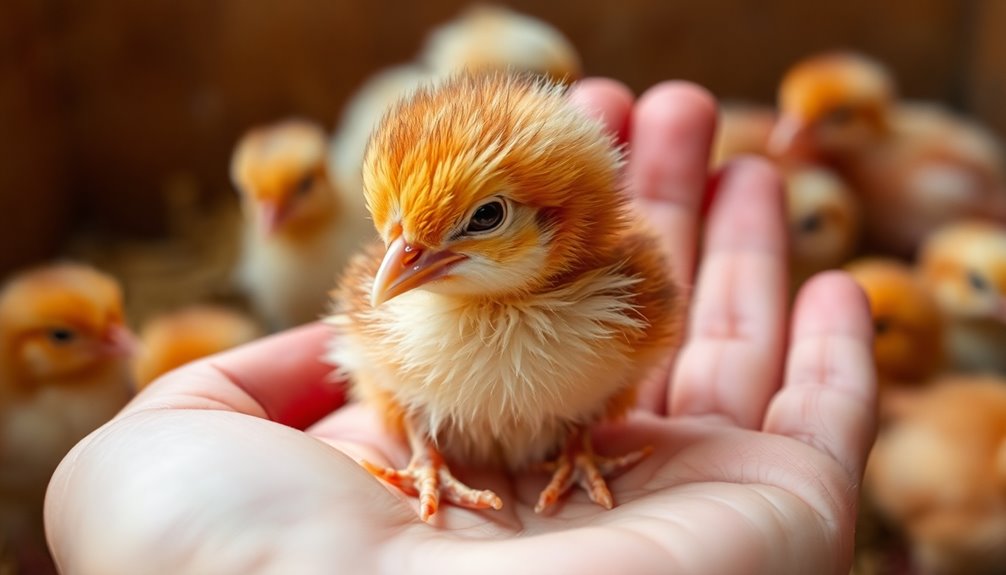The best time to have sex during ovulation is within your fertile window, which spans five days before ovulation and includes the day of ovulation itself. Since sperm can survive for up to five days, frequent intercourse during this period increases your chances of conception. You can identify ovulation through changes in cervical mucus or by tracking your basal body temperature. Ovulation predictor kits can also help pinpoint your most fertile days. By understanding these signs and tools, you'll enhance your likelihood of getting pregnant, and there's much more to discover on this topic.
Key Takeaways
- Have intercourse during the fertile window, which is five days before ovulation and the day of ovulation for optimal chances of conception.
- Utilize ovulation predictor kits to detect the LH surge, signaling the best time for intercourse.
- Monitor changes in cervical mucus; clear and stretchy mucus indicates peak fertility days.
- Track basal body temperature; a rise in BBT confirms ovulation has occurred, helping to time future intercourse.
- Engage in frequent intercourse during the fertile window, as sperm can survive in the reproductive tract for up to five days.
Understanding Ovulation and Fertility

Understanding ovulation is essential for enhancing your fertility. Ovulation typically occurs 12 to 16 days before your next menstrual cycle starts, making it crucial to track your cycle.
The fertile window includes the five days leading up to ovulation and the day of ovulation itself, maximizing your chances of conception. Sperm can survive in the female reproductive tract for up to five days, so timing sex before ovulation can increase your odds of fertilization.
You can recognize signs of ovulation through changes in cervical mucus, which becomes clear and slippery, and a slight rise in basal body temperature.
Using an ovulation test can help you detect hormone surges, ensuring you identify the best time for intercourse and support your reproductive health.
Optimal Timing for Intercourse

To maximize your chances of conception, timing your intercourse during the fertile window is essential. This window includes the five fertile days leading up to ovulation and the day of ovulation itself.
Since sperm can survive for up to five days, having sex every day or every other day during this period increases your likelihood of conception. The egg remains viable for only 12-24 hours after ovulation, making precise timing vital.
Utilize an ovulation predictor kit or track changes in clear vaginal discharge to identify your peak fertile days. By aligning your intercourse with your menstrual cycle and ovulation, you can greatly enhance your chances of successfully fertilizing the egg and achieving pregnancy.
Signs of Ovulation

Recognizing the signs of ovulation can greatly boost your chances of conception. During this phase, you'll notice changes in your cervical mucus, which becomes clear and stretchy, resembling raw egg whites—this indicates you're at peak fertility.
You might also experience an increase in libido and mild discomfort known as ovulation pain or mittelschmerz. Tracking your basal body temperature (BBT) can help too; a rise of 0.5 to 1 degree Fahrenheit usually signals that ovulation has occurred.
Additionally, using ovulation predictor kits (OPKs) can detect a surge in luteinizing hormone (LH) in your urine, typically occurring 12 to 36 hours before ovulation, helping you pinpoint the best time for intercourse.
Tools for Tracking Ovulation
Several effective tools can help you track ovulation and enhance your chances of conception. By utilizing these methods, you can gain better fertility awareness and pinpoint ideal timing for intercourse during your fertile window.
- Ovulation predictor kits (OPKs): Test urine for LH surge.
- Cervical mucus monitoring: Observe changes to clear vaginal discharge.
- Basal body temperature (BBT): Track daily temperature for ovulation confirmation.
- Apps and calendars: Analyze menstrual cycles for predicting fertile days.
- Fertility tracking devices: Monitor hormone levels and temperature continuously.
Using these tools not only aids in ovulation tracking but also empowers you with insights into your body's natural rhythms, helping you make informed decisions on conception.
Lifestyle Factors Affecting Fertility

While many factors can influence your fertility, lifestyle choices play a significant role in your overall reproductive health. Maintaining a healthy weight is essential, as both overweight and underweight conditions can disrupt ovulation. Smoking and heavy alcohol consumption can lower your chances of conception and negatively impact fertility. Regular moderate exercise enhances your reproductive health, but excessive training might lead to irregular ovulation. Additionally, be mindful of environmental factors; exposure to certain chemicals can delay pregnancy.
| Factor | Impact on Fertility | Recommendations |
|---|---|---|
| Weight | Disrupts ovulation | Maintain a healthy weight |
| Smoking | Impairs fertility | Quit smoking |
| Alcohol | Lowers fertility levels | Limit or avoid alcohol |
When to Seek Medical Advice

If you've been trying to conceive without success, it's important to know when to seek medical advice.
Healthy couples should consult a healthcare provider after a year of attempts, while those over 35 should do so after six months.
Recognizing fertility issues early can lead to better outcomes for both partners.
Timing for Medical Consultation
Knowing when to seek medical advice can make a significant difference in your journey to conceive. If you're trying to conceive and haven't had success after a year, it's time to consult a healthcare professional. For women over 35, this timeframe shortens to six months.
Early intervention is essential, especially if you have known conditions like endometriosis or PCOS. Remember that fertility problems can also stem from male factors, so both partners should be assessed.
Consider consulting a specialist if you:
- Experience irregular menstrual cycles
- Have difficulty timing ovulation
- Face repeated pregnancy losses
- Notice changes in your menstrual cycle
- Want to improve preconception health
Regular check-ups with a reproductive endocrinologist can greatly enhance your chances of conception.
Recognizing Fertility Issues
Recognizing fertility issues early can greatly impact your journey to conception. If you're under 35 and haven't conceived after a year of trying, or over 35 and still waiting after six months, it's time to seek help.
Irregular periods or known conditions like endometriosis and PCOS should prompt immediate consultation with a healthcare provider. Both partners should undergo assessments, as fertility challenges can arise from male factors in at least 50% of cases.
Consulting a gynecologist or reproductive endocrinologist could enhance your chance of getting pregnant through targeted interventions.
Frequently Asked Questions
Does Time of Sex Matter on Ovulation Day?
Yes, the timing of sex on ovulation day definitely matters. Engaging in intercourse on that day maximizes your chances of conception since the egg is at its peak viability.
If you time it right, you're more likely to achieve fertilization. However, remember that sperm can survive for several days, so having sex in the days leading up to ovulation is also beneficial.
It's all about creating the best conditions for success!
What Is the Best Sex Position to Get Pregnant on Ovulation Day?
So, you think there's a magic sex position that'll guarantee a mini-you?
Well, science suggests the missionary position might help with deeper penetration, placing sperm closer to the cervix.
Doggy style can also work, offering a different angle to aid the little swimmers.
Don't forget to keep your hips elevated afterward—pillow under the hips, anyone?
And remember, a relaxed vibe is essential; stress won't do you any favors in this baby-making adventure!
When Is Ovulation Highest to Get Pregnant?
When you're trying to conceive, understanding when ovulation is highest can greatly enhance your chances.
Ovulation typically peaks around 14 days before your next period, with the highest probability of pregnancy occurring in the three days leading up to ovulation and on the day itself.
Pay attention to your body's signals, like changes in cervical mucus, or use ovulation predictor kits to pinpoint the best time for conception.
When Is the Easiest Time to Get Pregnant During Ovulation?
When you're hoping to welcome a little one, understanding timing is key.
The easiest moments to conceive usually fall within your fertile window, which stretches around six days leading up to ovulation. The highest chances occur just before and on the day of ovulation.
Engaging in intimacy every day or every other day during this period maximizes your opportunities, so paying attention to your cycle can be incredibly beneficial for your journey.
Conclusion
To summarize, timing your intercourse around ovulation can greatly boost your chances of conception. Did you know that couples who have sex during the fertile window increase their odds of getting pregnant by up to 33% each cycle? By understanding your body, tracking ovulation, and recognizing its signs, you're taking essential steps towards your fertility goals. Remember, a little knowledge goes a long way, so stay informed and make each moment count!










